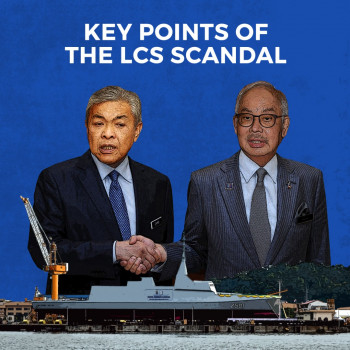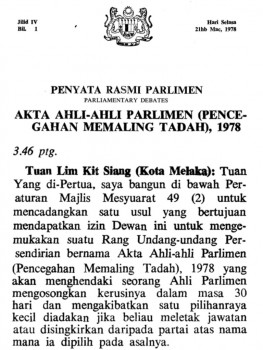The seed of the current water supply crisis in Selangor was laid in the 1990s in the midst of the BN’s privatisation drive of state’s assets. A synopsis of the facts shows who is telling the truth and who is robbing the people.
by T.K Tan
The previous state agency in charge of Selangor’s water resources, Jabatan Bekalan Air Selangor (JBAS), was making decent profits of RM 50 to 80 million annually in the 1980s, contributing substantially for the state’ coffers.
Selangor became the first state to privatise its water supply. However, only the profitable segment of the water industry, water treatment, was privatised. From 1997 to 2002, three companies, Puncak Niaga Holdings Bhd (PNHB), Syarikat Pengeluar Air Selangor Sdn Bhd (SPLASH) and Konsortium Abass Sdn Bhd (ABASS) received the water treatment concessions from the state for 20-25 years and at set prices.
The loss-making water distribution business was retained by the state government. It was corporatized into Pengurusan Air Selangor BHD (PUAS) in 2002. According to Dr Dzulkefly Ahmad, Kuala Selangor MP, while the private water treatment companies made annual profits ranging from RM 35 million to RM 180 million in 2001, PUAS lost around RM 350 million annually.
In 2004, PUAS’s role was then taken over by Syarikat Bekalan Air Selangor Sdn Bhd (SYABAS), a 70 percent subsidiary of PNHB while the rest of the shares were taken up by Selangor state government. The federal government holds one golden share in SYABAS which enables it to control any asset disposal or merger of SYABAS.
Cleaning Up Spilt Milk
In 2006, the Water Services Industry Act (WSIA) was passed in parliament. Its objectives were to consolidate all water industry-related assets, such as water treatment plants and water pipes throughout Peninsular Malaysia under one federal agency, Pengurusan Aset Air Bhd (PAAB).
In turn, PAAB was to lease back these assets to the respective water industry operators. It was also to undertake all new capital investment and maintenance of these assets.
This was to ensure optimum capital investment in water treatment and distribution assets, as private entities will lag in such investments. PAAB will also enjoy lower borrowing cost as it is a government entity. Theoretically PAAB could levy lower leasing charges to the water industry operators.
In January 2008, the cabinet decided that Selangor’s water industry restructuring exercise was to be undertaken by the Selangor state government. Pakatan Rakyat’s takeover of Selangor state government in March 2008 put a spanner in the works of BN’s ‘noble’ intention.
Reneging on a promise
PR had agreed to all points raised in the WSIA and the federal government’s intention to consolidate the water industry’s fragmented companies and make it a holistic entity. Selangor under PR intended to transfer some of its assets with the concessionaires’ assets to PAAB.
Since 2008, Selangor has made three offers to take over all the water concessionaires, the latest being in June 2011 where SPLASH and ABASS had accepted. However, PNHB and SYABAS had rejected it outright. (31 July 2012, The Edge)
To make matters worse, the federal government has chosen to side with PNHB and SYABAS. Not only has the federal government blocked the takeover exercise by the Selangor government (23 July 2012, Malaysiakini), it has even offered a lifeline to these financially strapped companies.
SYABAS and PNHB together have RM 4.2 billion in debts. In 2009, it granted an interest-free and unsecured RM320 million loan to SYABAS. Putrajaya has even offered RM6.5 billion to take over the water concessionaires’ downgraded bonds (3 June 2012, Selangor Times), giving the companies a lifeline.
Holding People To Ransom
SYABAS’s core issue is its inability to reduce its non-revenue water (NRW) rate of 32 percent. Around 25 percent of its NRW is attributed to ‘stolen water’ (i.e. not billed).
Questionably, SYABAS had imposed water rationing on some areas in Selangor despite the dams’ water level at optimal levels and the treatment plants running at capacity.
Despite its ineptitude, SYABAS has pressured the Selangor state government since 2008 to accede to its request to build a new water treatment plant, the infamous Langat 2 project that would cost RM 6.225 billion.
Curiously, the federal agency National Water Services Commission (SPAN) had rejected SYABAS’s RM 2.33 billion proposal for pipe repairing and replacement works. It reported 500 cases of burst pipes and another 6,000 cases of leaking pipes each month. (6 August 2012, Malaysiakini).
Audaciously the federal government has said it is cheaper to build the Langat 2 project to bolster the state’s water supply than to reduce the NRW from 32 percent to 20 percent. (12 July 2012, The Star).
What’s At Stake
Selangor under Pakatan has chosen to recognise the principle of reversing privatisation and renationalising water services so as to maintain or lower water tariffs for the people in the Selangor area.
Under the concession agreement signed by the previous BN state government, Selangor residents would had have to suffer water tariff hikes of 37 percent in 2009, 25 percent (2012), 20 percent (2015) and 10 percent (2018).
The Selangor PR government has blocked the hike. For that SYABAS is suing the state government for RM 1.05 billion for lost tariff income. For the record, Selangor has the second highest water tariff rates in Peninsular Malaysia.
By comparison, Penang’s water tariff is the lowest in the country and its water company PBA is a listed company that has return profits regularly.
In addition since 2009, Selangor has given all its residents 20 cubic metres of free water. In the process, up until April 2012 it has spent RM 525 million that has benefitted more than four million people in this program that is a part of its Merakyatkan Ekonomi Selangor (Making The Selangor Economy People First) program list. – The Rocket




